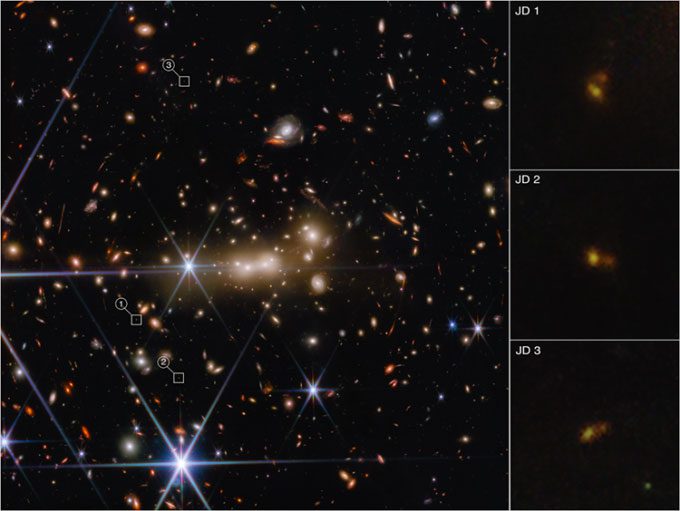The James Webb Space Telescope has observed the galaxy cluster MACS0647 bending light from the system MACS0647-JD, causing it to appear in three distinct locations.
First discovered a decade ago, the MACS0647-JD system only appeared as “a faint red dot” in older images taken by the Hubble Space Telescope. However, in a recent report on October 26, NASA announced that this system actually consists of two massive structures rather than just one as previously thought.
This groundbreaking discovery was made possible by the unprecedented sharp observations of the James Webb Space Telescope. NASA’s $10 billion super telescope utilized the gravitational lensing effect of the MACS0647 galaxy cluster to capture images of MACS0647-JD (gravitational lensing is an astronomical phenomenon that occurs when light emitted from an object is bent due to the gravitational influence of other objects it passes near).

The MACS0647-JD system appears in three different locations in the new images from Webb due to the gravitational effect from the MACS0647 galaxy cluster. (Image: NASA)
The use of gravitational lensing is not new in astronomy, but Webb’s sensitive infrared instruments—optimized for observing the early universe—are providing new insights.
Due to the extremely strong gravitational forces of the MACS0647 galaxy cluster, light from the distant MACS0647-JD system has been bent and magnified by factors of 8, 5, and 2, causing it to appear in three locations labeled JD1, JD2, and JD3 in the images captured by the James Webb Telescope.
When zooming in on these three images, they reveal that MACS0647-JD consists of two distinct structures, although scientists are still uncertain about what they are. “We are actively discussing whether these are two galaxies or two star clusters within a galaxy,” said astronomer Dan Coe from the Space Telescope Science Institute.
If MACS0647-JD is a system of two galaxies, there is a fascinating possibility that we are observing the merger event of two galaxies in the early universe, occurring only about 400 million years after the Big Bang.
“Studying MACS0647-JD could help us better understand how ancient galaxies evolved into galaxies like the ones we live in today, as well as how the universe has developed over that time,” emphasized co-author Rebecca Larson, a Ph.D. candidate at the University of Texas at Austin.





















































